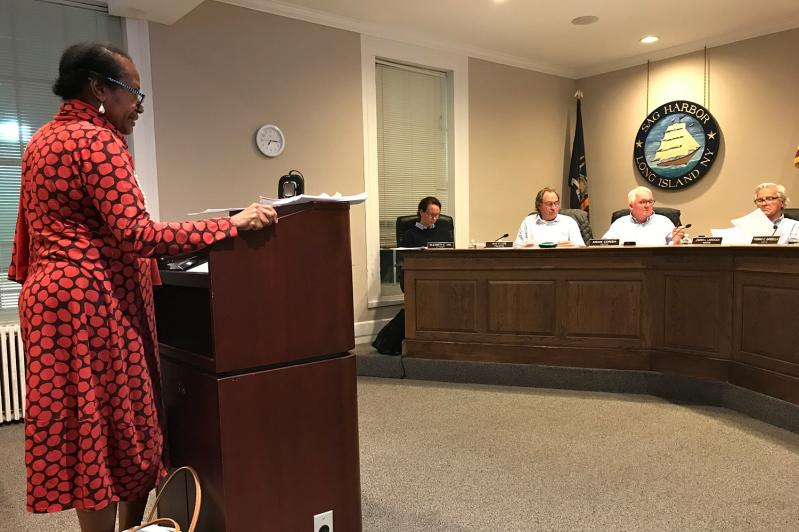The Sag Harbor Village Board of Trustees proposed a new law on Tuesday, which would create an overlay district in what the board called its “historically black beachfront communities.” Before the proposed amendment to the village code can take effect, however, it will have to go through a public hearing, on Nov. 8.
If the discussion at this week’s meeting was any indication of what’s ahead, it won’t be easy.
There are two opposing sides involved. Ironically, both agree on what seems to be the main issues: That the recent real estate boom threatens to change the character of the Sag Harbor Hills, Azurest, and Ninevah, collectively called SANS, neighborhoods and that preservation is necessary.
The Tri-Community Working Group, which includes the presidents of each subdivision plus 14 residents, supports the proposed overlay district, and claims that 95 percent of SANS residents are all for it.
According to a preliminary draft, the overlay district “allows for distinct zoning regulations that will allow redevelopment, while at the same time ensuring a significant limit on the expansion of single-family residences that will maintain the community character of this important area.”
Renee Simons, president of the SANS Organization, who is not a member of the Tri-Community Group, was not at an August board meeting when the group first presented the overlay plan to the village board. On Tuesday, she asked to be heard by the board.
To start, she had an issue with the name “historically black beachfront communities.”
“The name of the project should be the SANS Historic District,” she said, “so it’s consistent with its designation on the National Register, in the Library of Congress.”
She gave a brief history of Sag Harbor’s traditionally Black communities. The first of the 20th century, established in the 1930s, was Chatfield Hills, followed by the three subdivisions now known as SANS, and then by Hillcrest Terrace. “Hillcrest Terrace was the last, and yet today it is the first disappeared,” Ms. Simons said. Its entrance sign was removed; its homeowners association dissolved. “Who knew this fading history could happen?” she asked.
For seven years, she said, SANS, founded in 2016, has asked the village board, unsuccessfully, for historic preservation, in line with the village’s duties as a Certified Local Government — a designation granted by the federal government, with coordination by the state, to help preserve places deemed historic. While the SANS communities are on the New York State and National Historic Registers, Ms. Simons fears that without local recognition, its history will vanish.
“C.L.G. rules would absolutely make SANS a historic district. Full stop,” she wrote in an email to The Star. “The village would have the oversight responsibility to really try to honor scale and character in the neighborhoods. Otherwise, we can variance our way to McMansions again.”
As proposed, she told the village board, the overlay district could lead to the “unlimited demolition of 300-plus homes, covering 150 acres of the village. That’s not preservation, that’s decimation.” It is important, she added, for the word “historic” to remain. “Experiential knowledge wanes if not reinforced. If Sag Harbor walked away from its whaling history, would folks recall that it was American’s number-one port years ago? No. Many do not recall today!”
Much of what the Tri-Community Working Group has proposed was previously submitted by the SANS Organization, she noted. Specific rules, she argued, would be enough to help people know how they could expand or renovate their houses. Without such specifics, she said, developers with unlimited reserves could change everything.
Ms. Simons also refuted several assertions that she said were false, chief among them that residents in a historic district wouldn’t be able to renovate and rehabilitate their homes. She offered Sag Harbor’s John Jermain Library as an example of a historic structure that was successfully renovated. She also pushed back on the notions that house values in historic districts fall, and that any house over 50 years old automatically joins the district as a “contributing building.” Owners are strictly limited as to what kinds of changes they can make to contributing buildings.
“Only two percent of properties on the National Historic Register have to do with African-American neighborhoods,” Ms. Simons said. “SANS is one of them. It is our duty to be on the right side of history and preserve it.”
After she finished, Errol Taylor, president of the Ninevah Beach Association, rose to speak, despite Mayor James Larocca’s attempts to quell debate. “Much of what she said is inaccurate,” said Mr. Taylor. “To leave the impression that there’s some overwhelming desire to do an architectural designation would be improper.”
The mayor reminded Mr. Taylor that he could air his complaints at the public hearing. “Obviously this is a supercharged matter,” he said.
“SANS is passionate, but they do not represent the African-American homeowners in our SANS community,” replied Mr. Taylor.
“This is not a public hearing,” said Mayor Larocca. “That’s when we should get everything up onto the table. We’ve gone formal with this law introduction so we can bring the debate into the public domain.”
In her email, Ms. Simons said that an overlay district would just be more village code, which could change. “It’s like an administration’s executive order. The overlay plays at providing preservation but can lose the sense of community. This new wave of commercial ownership and renting kills the sense of community historically available and enjoyed.”




